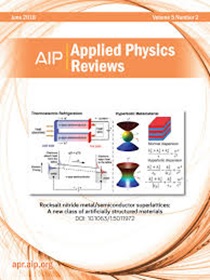细胞外囊泡作为基因治疗的药物传递载体
IF 11.6
1区 物理与天体物理
Q1 PHYSICS, APPLIED
引用次数: 0
摘要
细胞外囊泡(EVs)是由细胞自然分泌的膜结合纳米颗粒,在细胞间通讯中起着至关重要的作用,作为治疗药物具有重要的前景。这些天然载体将各种分子运送到细胞中,包括蛋白质和核酸。装载和修改电动汽车的方法有很多,包括物理、化学和生物方法。EVs显示出靶向器官内特定细胞的能力,甚至需要血液组织转换。蛋白质电晕显著影响EV的有效性和货物递送,生物分子既存在于EV膜内,也结合在EV膜上。此外,将电动汽车嵌入水凝胶、支架和纳米纤维等生物材料中可以提高其稳定性、靶向特异性和治疗潜力。通过处理货物装载和细胞/组织特异性靶向,ev为多种疾病提供了一种新的治疗策略,包括癌症、自身免疫性疾病和神经退行性疾病。此外,电动汽车有望作为疫苗接种工具,传递各种病原体的信使RNA和蛋白质。EV生物学和工程学的进步将为囊泡靶向、增强货物装载和安全有效的递送提供改进的策略。技术进步、跨学科合作和对电动汽车的深入了解的融合有望彻底改变各种疾病的治疗方法,使基于电动汽车的治疗成为未来医学的基石。本文章由计算机程序翻译,如有差异,请以英文原文为准。
Extracellular vesicles as the drug delivery vehicle for gene-based therapy
Extracellular vesicles (EVs) are membrane-bound nanoparticles naturally secreted by cells, playing a vital role in intercellular communication and holding significant promise as therapeutic agents. These natural carriers deliver various molecules into cells, including proteins and nucleic acids. There are numerous methods to load and modify EVs, encompassing physical, chemical, and biological approaches. EVs demonstrate the capacity to target specific cells within organs, even requiring blood–tissue transition. The protein corona significantly influences EV availability and cargo delivery, with biomolecules residing both within and conjugated to the EV membrane. Furthermore, embedding EVs within biomaterials such as hydrogels, scaffolds, and nanofibers can enhance their stability, targeting specificity, and therapeutic potential. By addressing cargo loading and cell/tissue-specific targeting, EVs offer a novel therapeutic strategy for various diseases, including cancer, autoimmune disorders, and neurodegenerative diseases. Furthermore, EVs show promise as vaccination tools, delivering messenger RNA and proteins of various pathogens. Advances in EV biology and engineering would provide improved strategies for vesicle targeting, enhanced cargo loading, and safe and effective delivery. The convergence of technological advancements, interdisciplinary collaboration, and an enhanced understanding of EVs promises to revolutionize therapeutic approaches to a wide range of diseases, establishing EV-based treatments as a cornerstone of future medicine.
求助全文
通过发布文献求助,成功后即可免费获取论文全文。
去求助
来源期刊

Applied physics reviews
PHYSICS, APPLIED-
CiteScore
22.50
自引率
2.00%
发文量
113
审稿时长
2 months
期刊介绍:
Applied Physics Reviews (APR) is a journal featuring articles on critical topics in experimental or theoretical research in applied physics and applications of physics to other scientific and engineering branches. The publication includes two main types of articles:
Original Research: These articles report on high-quality, novel research studies that are of significant interest to the applied physics community.
Reviews: Review articles in APR can either be authoritative and comprehensive assessments of established areas of applied physics or short, timely reviews of recent advances in established fields or emerging areas of applied physics.
 求助内容:
求助内容: 应助结果提醒方式:
应助结果提醒方式:


